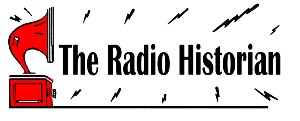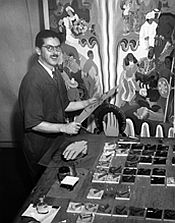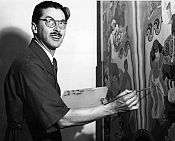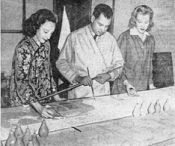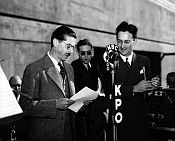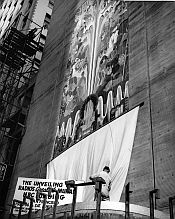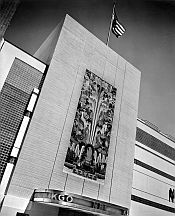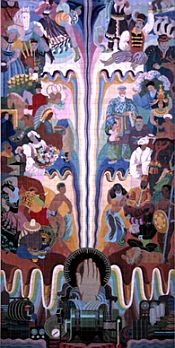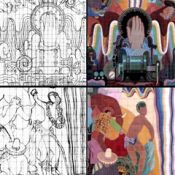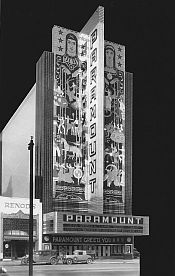THE
CREATION OF SAN FRANCISCO's
NBC RADIO CITY MURAL
By John Schneider, W9FGH
www.theradiohistorian.org
Copyright 2018 -
John F. Schneider & Associates, LLC
(Click on photos to enlarge)
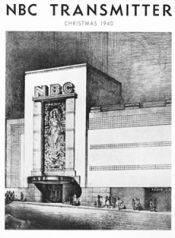
An architect’s rendering of the NBC studio building, showing the preliminary image of a different mural, 1940.
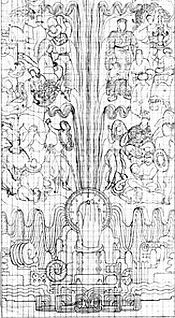
Fitzgerald's original concept sketch
of his NBC mural
Fitzgerald is seen working on his oil painting rendition of the mural, matching each individual color to the glazed tile samples laid out on the table in front of him
Another view of Fitzgerald working on his oil painting.
Fitzgerald is seen
speaking at the dedication ceremony of the Radio City mural, on
January 17,
1942
The grand unveiling
of the mural on
January 17, 1942.
Fitzgerald’s completed mural, 1942.
The finished mural, in full color, as seen today.
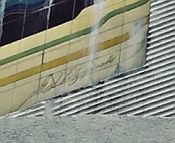
Fitzgerald's signature on the NBC mural
CREATING OF A WORK OF ART:
There is a fascinating story
associated with the ceramic
tile mural that graces the façade of the NBC Radio City Building in San
Francisco (now known as the 420 Taylor Building).
The author was fortunate to acquire the files
of the mural’s designer, architect Gerald F. Fitzgerald, which revealed
a
number of heretofore little-known details.
In 1941, when the building was
first being designed and constructed,
it was decided that an important feature of the façade would be an
imposing
mural set into the 80 foot pylon that was to rise above the entrance
marquee. But the
subject of the mural
was yet to be decided. Early
architectural drawings of the building depict the large figure of a
standing
woman with nondescript figures scattered around her.
In reality, this was just a conceptual
drawing to the fill the space, and the true nature of the mural was yet
unknown.
As construction progressed, a
committee was formed to decide
on the artwork and implementation of the mural.
It consisted of Albert Roller, the building’s chief
architect; Roller’s
architural designer, Gerald. F.
Fitzgerald; Al
Nelson, NBC assistant
vice president in charge of San Francisco operations; O. B. Hanson,
NBC’s vice
president of engineering; William
A.
Clark, the manager of NBC Technical Services; and Curtis Peck, chief
engineer
of NBC’s San Francisco operations. Scores
of ideas were discussed by the committee, but they could not come to an
agreement. Outside
artists and sculptors
were invited to submit suggestions, and yet weeks passed without a
decision. Finally,
Fitzgerald proposed a
mural that would portray radio broadcasting serving all the peoples of
the
world. He submitted
a rough sketch, and
it won unanimous approval by the design committee.
Fitzgerald was then put in charge of the
design and execution of the mural project.
His design depicts the story of
radio broadcasting as a
means of mass communication reaching all the peoples of the earth. The mechanics of
broadcasting are represented
at the bottom of the work, with condensers, a dynamo, stop watch,
insulators,
transmitter tubes, a thermometer, wiring symbols, and an RCA
microphone. Immediately
above that, a large human hand adjusts
a radio dial creating radio waves that extend upwards towards the very
top of
the mural. On each
side of the wave, more
than 50 characters are depicted. They
represent
populations from the South Seas to the Arctic, from the Orient to the
West, and
from the tropics to the poles. The Oriental peoples are seen on the
right, and western
populations are at left; the
people of
the tropics are at the bottom, and the Arctic regions are represented
at top. Individual
characters portrayed include Africans
with a lion, Asians with a Chinese mandarin, and the peoples of Spain,
Mexico
and South America. There
are an American
cowboy and Indian, a Canadian Mountie, and an English riding gentleman. Balkans, Scandinavians, a
Cossack are
represented; an
Eskimo is seen with a polar
bear, penguins, a totem pole and an igloo. Also depicted are a
bullfighter, a
head hunter, an artist, reindeer, dancing girls and a Scottish piper.
The committee then turned to
the details of the physical
construction of the mural . It
would be
16 feet wide and 40 feet high. The
façade of the concrete wall that would surround the mural would be
textured
with horizontal fluting; the shadows caused by the fluting were
designed to
darken the surface to the eye, thus creating a darker grey background
for the
mural.
Most murals of the early 20th
century were
painted on indoor walls, allowing the portrayal of extremely fine
details. But
outdoor murals typically were constructed
of small single-colored colored tiles that were assembled to create an
image. This
technique would not display
the level of finer detail of the individual characters that were
depicted in
Fitzgerald’s drawing. In
a search for a
method to display such detail in an outdoor work, the committee’s
attention was
drawn to the artistry of the ceramics manufacturer Gladding, McBean
& Co.,
in Glendale, California, and it soon met with Leon G. Levy, the
company’s vice
president. Levy
offered a concept that
had never been attempted before – the mural could be built from
individual six-inch-square
glazed tiles, and each tile would be hand colored with small segments
of the
total image. The
square tiles would be
set end-to-end, with no mortar separating them, to form a continuous,
detailed
image. Unlike other
methods, the brilliant
colors of these glazed tiles would never fade with time.
At the ceramics shop, work
began on making the 2,560
individual six-inch tiles that would be used for the project. The materials for each
tile were mixed from a
finely-ground combination of talc, silica, rock and clay. They were pre-cut to their
precise size, with
an allowance for shrinkage during firing, so that each finished tile
would be
accurate in size within 1/13,000th of an inch. The tiles were fired as
they moved for 2-1/2
hours through a 108-foot-long kiln tunnel heated to 2,150 degrees F. After firing, graphic
artist Marcello Maruffo
drew the lines of each image segment onto the raw tiles, and then a
crew of
female artisan workers flowed the metallic oxide colors onto each tile
from
syringes. Once the
tiles dried, the
glaze was applied and they then made a second trip through the kiln
tunnel –
this time for 16 hours at 2,000 degrees F.
Finally, a grand unveiling
ceremony was held on January 17,
1942. The one-hour
event took place in
front of a live audience on a temporary outdoor stage constructed at
the front
of the NBC building. The
second half of
the event was broadcast live over NBC’s station KPO.
The dedicatory program consisted of dignitary
speeches, music by the NBC orchestra and the Symphonic Seven jazz band,
songs
by several local vocalists, and an original tone poem by Forrest Barnes. Finally, Fitzgerald
himself was introduced to
make a short statement:
Thank
you John Galbraith. It
is a new
experience for me as an architect to be called an artist. In accepting this very
high honor which you
bestow on me, I should like to acknowledge the enthusiastic support
given me by
Mr. Albert Roller and the friendly criticism of Mr. Nelson Poole, the
skillful
workmanship of the Gladding, McBean Company in Glendale where these
tiles were
manufactured, and the Sunset Tile Company of San Francisco who set them
in
place. In
creating this mural, I have
attempted to portray the unlimited scope of radio broadcasting, and its
service
to all the peoples of the world. Thank
you.
The grand finale to the program
was the dropping of the
canvas covering, and the creator and audience alike were treated to its
first
view of Fitzgerald’s masterpiece mural, which continues to grace the
streets of
San Francisco to this day.
FOOTNOTE:
Very little
is known about the artist, Gerald J. Fitzgerald.
It was reported at the time that he had studied
architecture at the University of California in Berkeley, and then
worked for
the architectural firm Miller & Pflueger during the design of
stately the
Paramount Theatre building in Oakland.
According
to David Boysel, curator of the Paramount Theatre, Fitzgerald designed
the two
large gilded murals that still grace the front of that imposing
structure, and was
also responsible for the designs of the grand lobby and auditorium
ceiling. Apparently,
he also served as an architectural
consultant during the construction of the Bay Bridge.
Fitzgerald left the employment of Miller
& Pflueger sometime in the late 1930s, and was working for
Albert Roller at
the time of the NBC building project.
However,
nothing is known about Fitzgerald’s work or his life after he completed
the NBC
mural. His legacy
survives in the form
of the two great building murals he designed, which fortunately still
survive
today. If one looks
closely at the Radio
City mural, they can see Fitzgerald’s signature in the tiles at the
lower
right-hand corner.
www.theradiohistorian.org
John F. Schneider & Associates, LLC
Copyright, 2018
